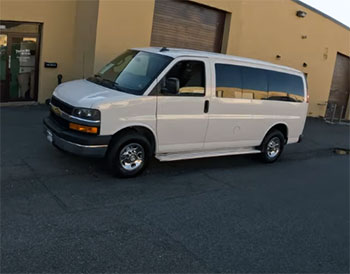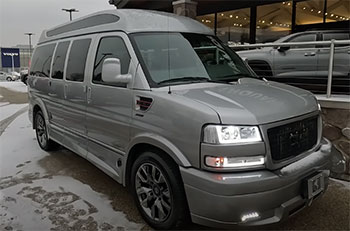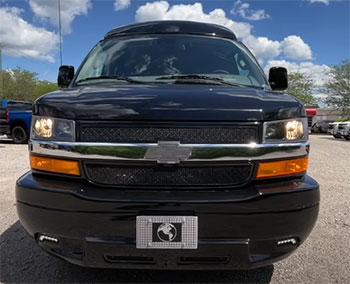As a small business owner who’s spent years hauling cargo and shuttling crews, I’ve had my fair share of time behind the wheel of full-size vans. The Chevrolet Express and GMC Savana, two of General Motors’ longest-running workhorses, have been my go-to options for their reliability and versatility.
In this article, I’ll compare these nearly identical vans, exploring their features, performance, and quirks to help you decide which one suits your needs. From their shared engines to subtle differences in pricing and branding, I’ll break down what makes each van tick and where they fall short.
Comparison Table: Chevrolet Express Vs. GMC Savana
| Feature | Chevrolet Express | GMC Savana |
|---|---|---|
| Starting MSRP (2025) | $41,800 | $49,245 |
| Engine Options | 4.3L V6 (276 hp), 6.6L V8 (401 hp) | 4.3L V6 (276 hp), 6.6L V8 (401 hp) |
| Transmission | 8-speed automatic | 8-speed automatic |
| Payload Capacity | Up to 4,280 lbs (3500 series) | Up to 4,280 lbs (3500 series) |
| Cargo Space | 239.4 cu. ft. (short wheelbase), 284.4 cu. ft. (long wheelbase) | 239.4 cu. ft. (short wheelbase), 284.4 cu. ft. (long wheelbase) |
| Towing Capacity | Up to 10,000 lbs (V8) | Up to 10,000 lbs (V8) |
| Warranty | 3-yr/36,000-mile basic, 5-yr/60,000-mile drivetrain | 3-yr/36,000-mile basic, 5-yr/60,000-mile drivetrain |
| Unique Features | More dealerships (73% more than GMC), slightly cheaper | “Limp home” system for coolant loss |
| Fuel Economy | Not rated (varies by load/driving conditions) | Not rated (varies by load/driving conditions) |
| Reliability Rating | Higher per Consumer Reports (2024) | Slightly lower per Consumer Reports (2024) |
My Experience With the Chevrolet Express

I’ve driven the Chevrolet Express for countless jobs, from delivering equipment to transporting my team to construction sites.
Introduced in 1996 as the successor to the Chevrolet G-series, the Express has barely changed in nearly three decades, and honestly, that’s part of its charm.
It’s a no-nonsense van built for work, not flash. Its boxy design maximizes cargo space, and the body-on-frame construction, borrowed from GM’s trucks, gives it a rugged feel that’s perfect for heavy-duty tasks.
I’ve hauled everything from lumber to plumbing supplies in the 2500 cargo model, and it’s never let me down.
The Express comes in two wheelbases—135-inch and 155-inch—and offers both passenger and cargo configurations. I’ve mostly used the 135-inch cargo version, which gives me 239.4 cubic feet of space.
When I needed more room, the extended 155-inch model bumped that up to 284.4 cubic feet, which was a game-changer for larger loads. The standard 4.3L V6 engine, producing 276 horsepower, handles city driving fine, but I opted for the 6.6L V8 (401 hp) when towing trailers up to 10,000 pounds. The eight-speed automatic transmission shifts smoothly, though it’s not winning any awards for cutting-edge tech.
What I appreciate most is the Express’s simplicity. The interior is spartan—think vinyl seats and basic controls—but it’s durable. I’ve spilled coffee, dropped tools, and tracked mud inside, and it still cleans up easily. The dashboard layout hasn’t changed much since the early 2000s, which means it’s intuitive but dated.
Safety features like rearview cameras and optional blind-spot monitoring are nice, but don’t expect modern luxuries like adaptive cruise control. For me, the Express is about getting the job done, not pampering the driver. Plus, with 73% more Chevrolet dealerships than GMC, I’ve never struggled to find service when needed.
That said, the Express isn’t perfect. Fuel economy is a mystery—GM doesn’t publish official numbers, but I’ve averaged around 12-13 mpg in mixed driving, worse when loaded. The lack of a high-roof option can be limiting for some businesses, and the absence of all-wheel drive (discontinued after 2014) makes it less ideal for snowy regions. Still, its affordability (starting at $41,800) and widespread parts availability make it a practical choice for anyone who values function over form.
My Experience With the GMC Savana

The GMC Savana feels like the Express’s slightly fancier twin. I’ve driven it for similar jobs—hauling gear, shuttling crews—and it’s nearly identical in performance and design. Launched alongside the Express in 1996, the Savana shares the same GMT610 chassis, engines, and configurations. I’ve used the 3500 extended model for bigger projects, and its 284.4 cubic feet of cargo space is identical to the Express. The 6.6L V8, paired with the eight-speed automatic, delivers the same 401 horsepower, making it a beast for towing or heavy payloads up to 4,280 pounds.
What sets the Savana apart is its branding and a few minor features. GMC markets itself as a premium brand, so the Savana feels like it’s aimed at buyers who want a touch more prestige. I noticed the “limp home” system, which lets the van run on half its cylinders if it loses coolant—a lifesaver during a job when a hose sprang a leak. The interior is just as utilitarian as the Express, but some trims have slightly nicer touches, like available chrome accents. Still, don’t expect luxury; it’s a work van, not a Cadillac.
Driving the Savana feels familiar if you’ve been in an Express. The steering is heavy but precise, and the suspension handles rough roads well, though fully loaded, it can feel bouncy. I’ve taken it through city traffic and rural backroads, and it’s reliable, if not exciting. The lack of fuel economy ratings is frustrating, but I got similar mileage to the RTT@Express—around 12 mpg in the city, maybe 15 on the highway. The Savana’s higher starting price ($49,245) gave me pause, especially since it’s mechanically identical to the Express. However, some buyers swear by GMC’s brand loyalty, and I get it—there’s a certain pride in driving a GMC.
The downside? Like the Express, the Savana lacks a high-roof option, and its rear-wheel-drive setup can struggle in bad weather. I also found that GMC dealerships are less common, which can be a hassle for repairs. Still, the Savana’s durability and shared parts with the Express make it a solid contender for anyone needing a dependable work van.
Pros Of the Chevrolet Express
- Affordable Price Point: Starting at $41,800, the Express is notably cheaper than the Savana, saving you upwards of $7,000. This makes it a budget-friendly option for small businesses or startups looking to maximize value without sacrificing capability. I’ve found the lower cost especially helpful when outfitting multiple vans for my crew.
- Widespread Dealership Network: With 73% more Chevrolet dealerships than GMC, finding service or parts is a breeze. I’ve had to replace a alternator on a job site, and the local Chevy dealer had it in stock, getting me back on the road in hours.
- Reliable Performance: Consumer Reports ranks the Express higher in reliability than the Savana based on 2024 data. I’ve put over 100,000 miles on my 2500 model, and with regular maintenance, it’s still running strong. The body-on-frame design feels indestructible.
- Versatile Configurations: Whether you need a cargo van for deliveries or a passenger van for shuttling up to 15 people, the Express has you covered. I’ve used both, and the flexibility to switch between setups has been a lifesaver for my business.
- Powerful Engine Options: The 6.6L V8 is a standout, delivering 401 horsepower and 464 lb-ft of torque. Towing a 10,000-pound trailer feels effortless, and even the base 4.3L V6 handles lighter loads well. I’ve never felt underpowered, even on steep inclines.
- Ample Cargo Space: With up to 284.4 cubic feet in the extended model, I’ve hauled everything from drywall to generators without issue. The flat floor and wide rear doors make loading and unloading straightforward.
- Extensive Parts Availability: Since the Express has been around since 1996 with minimal changes, parts are cheap and easy to find. I’ve sourced replacement mirrors and brakes from local auto shops without breaking the bank.
Cons Of the Chevrolet Express

- Poor Fuel Economy: Without official mpg ratings, it’s hard to plan fuel costs, but I’ve rarely gotten above 13 mpg. Heavy loads and city driving tank efficiency, which can add up for businesses with tight margins.
- Dated Interior: The cabin feels like a time capsule from the early 2000s. The plastic dashboard and basic controls are durable but lack modern touches. I’ve wished for a better infotainment system during long drives.
- No High-Roof Option: Unlike competitors like the Ford Transit, the Express doesn’t offer a high-roof variant. This limits its appeal for businesses needing extra vertical space, like delivery services or camper conversions.
- Rear-Wheel Drive Only: Since AWD was discontinued in 2014, the Express struggles in snow or mud. I’ve had to add winter tires and extra weight in the back to manage icy roads, which isn’t ideal.
- Limited Advanced Safety Features: While it has basics like airbags and a rearview camera, the Express lacks adaptive cruise control or automatic emergency braking. I’ve had to stay extra vigilant in busy traffic.
- Noisy Cabin: The van’s boxy shape and minimal soundproofing make for a loud ride, especially on highways. Long trips can be fatiguing, and I’ve resorted to earplugs on occasion.
- Lower Resale Value: Compared to the Savana, the Express tends to have a slightly lower resale value due to its budget branding. When I sold my old 1500 model, I didn’t get as much as I’d hoped.
Pros Of the GMC Savana
- Limp Home System: The Savana’s unique coolant loss protection system saved me once when a radiator hose failed. It reduced power but got me to a mechanic without stranding me—a feature the Express lacks.
- Strong Brand Loyalty: GMC’s premium branding resonates with some buyers. I’ve met contractors who swear by the Savana for its perceived durability, even if it’s mechanically identical to the Express.
- Powerful V8 Option: Like the Express, the 6.6L V8 delivers 401 horsepower, making it ideal for heavy towing. I’ve pulled equipment trailers with ease, and the engine feels bulletproof.
- Spacious Cargo Area: The 284.4 cubic feet in the extended model matches the Express, and I’ve packed it to the brim with tools and materials. The layout is practical for organizing cargo.
- Durable Construction: The body-on-frame design, shared with GM trucks, is built to last. I’ve driven Savanas over rough construction sites, and they hold up as well as the Express.
- Towing Capacity: With up to 10,000 pounds of towing capability, the Savana handles heavy loads like a champ. I’ve towed large generators without breaking a sweat.
- Consistent Design: The unchanged design since 1996 means mechanics know these vans inside out. I’ve had quick, affordable repairs because parts are so widely available.
Cons Of the GMC Savana
- Higher Price Tag: Starting at $49,245, the Savana is pricier than the Express with no significant mechanical differences. I’ve struggled to justify the extra cost for what feels like a branding premium.
- Fewer Dealerships: With fewer GMC dealerships, service can be harder to find. I once had to drive 50 miles to get a warranty repair, which was a hassle compared to the Express’s network.
- Poor Fuel Efficiency: Like the Express, the Savana guzzles gas, averaging 12-13 mpg in my experience. This can be a budget-killer for businesses with frequent driving.
- Outdated Interior: The cabin is nearly identical to the Express, with a dated dashboard and minimal tech. I’ve wished for a modern infotainment system or better climate controls.
- No High-Roof Option: The lack of a high-roof variant limits its versatility. I’ve had to turn down jobs requiring taller cargo space, which competitors like the Ford Transit can handle.
- Rear-Wheel Drive Limitations: Without AWD, the Savana struggles in adverse weather. I’ve had to be cautious in winter, relying on snow tires to avoid getting stuck.
- Slightly Lower Reliability: Consumer Reports’ 2024 data ranks the Savana slightly below the Express in reliability. While I haven’t had major issues, this gives me pause for long-term ownership.
Frequently Asked Questions (FAQ)
Yes, they’re mechanically identical, sharing the same chassis, engines, and design. The main differences are branding, pricing, and the Savana’s “limp home” system.
Yes, the Express is highly reliable, especially with regular maintenance. Consumer Reports ranks it higher than the Savana, and I’ve driven mine over 100,000 miles without major issues.
The Savana’s higher MSRP ($49,245 vs. $41,800 for the Express) reflects GMC’s premium branding and minor features like the “limp home” system, though the vans are nearly identical.
The Savana is reliable but slightly less so than the Express per Consumer Reports’ 2024 data. I’ve found it dependable for work, but maintenance is key.
Conclusion: For Chevrolet Express and GMC Savana
Choosing between the Chevrolet Express and GMC Savana comes down to your priorities. If you’re like me, valuing affordability and easy access to service, the Express is the better pick with its lower price and vast dealership network. Its reliability and versatility make it a workhorse you can trust for years. However, if you’re drawn to GMC’s brand prestige or need the “limp home” system for peace of mind, the Savana’s worth considering, despite its higher cost. Both vans deliver on durability and power, but their dated designs and lack of modern features mean you’re choosing function over flair. For most, the Express’s value edges out the Savana, but either way, you’re getting a proven van that’s stood the test of time. Pick what fits your budget and brand loyalty, and you won’t be disappointed.

